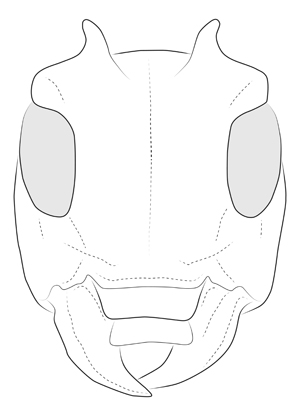 |
 back to Twig Girdlers back to Twig Girdlers
Onciderini Diagnostic Features
Unfortunately, there are no synapomorphies which clearly define this tribe. Instead, Onciderini has been defined by a combination of characters which are all found in other genera of Lamiinae. Indeed, there are genera of African and Australian Lamiinae which possess most (if not all) of the characters which have traditionally defined Onciderini.
The following short list of characters will help to determine if you have an Onciderini specimen. See the description section below for a more detailed account.
- antennal tubercles generally prominent
- scape without apical cicatrix (except in Cicatrodea)
- pronotum generally transverse (rarely subquadrate or elongate)
- humeri generally with prominent tubercles
- elytral apices individually or jointly rounded (rarely subtruncate or bidentate)
Description: Distinctly elongate to elongate-oblong or elongate-ovate, small to large-sized, generally robust, ranging from about 7–32 mm in length. Head with frons variable in shape, from elongate to subquadrate to transverse; frons width variable, from narrow (less than width of one lower eye lobe) to wide (about as wide as width of five or more lower eye lobes); frons surface roughly sculptured or not. Eyes with lower lobes variable in size and shape, from small to large, ovate to oblong to distinctly narrow. Genae variable in shape from elongate to subquadrate to transverse, ranging from distinctly shorter to taller than lower eye lobe. Antennae 11-segmented; antennal tubercles generally prominent, ranging from narrowly separated, contiguous at base, to widely separated; tubercles not armed at apex, or armed with a small to large projection; antennae highly variable in length, ranging from distinctly shorter than overall body length to about twice as long (about 3 times as long in Pericasta); scape shape variable, from gradually expanded to apex to clavate; scape without apical cicatrix (except in Cicatrodea); antennomere III variable in shape and often sexually dimorphic, from nearly straight to curved to sinuous (strongly elliptical in males of Clavidesmus, Eudesmus, Strioderes, Psyllotoxus); antennomere XI distinctly longer than X in males of some species (e.g. Psyllotoxus); antennae annulate in many genera. Pronotum generally transverse, rarely subquadrate, roughly cylindrical to strongly conical, with or without lateral tubercles. Elytra with sides variable, from attenuate to apex to distinctly wider towards apical 1/2; elytral apices individually or jointly rounded (bidentate in Ecthoea, subtruncate in Paratrachysomus); elytral coloration variable; base of elytra with or without prominent tubercles at humeri. Basal 1/3 of elytra not punctate to densely punctate, surface punctation variable. Procoxae with or without projection; procoxal projection variable in shape, males of some species with distinctly curved hook. Mesosternal process with apex subtruncate, or feebly to deeply emarginate. Metafemora variable in length, ranging from about 1/2–1/5 as long as elytra. Tarsal claws divergent and simple.

|
 |

Glypthaga xylina, head illustration
© E.H. Nearns |
 |



